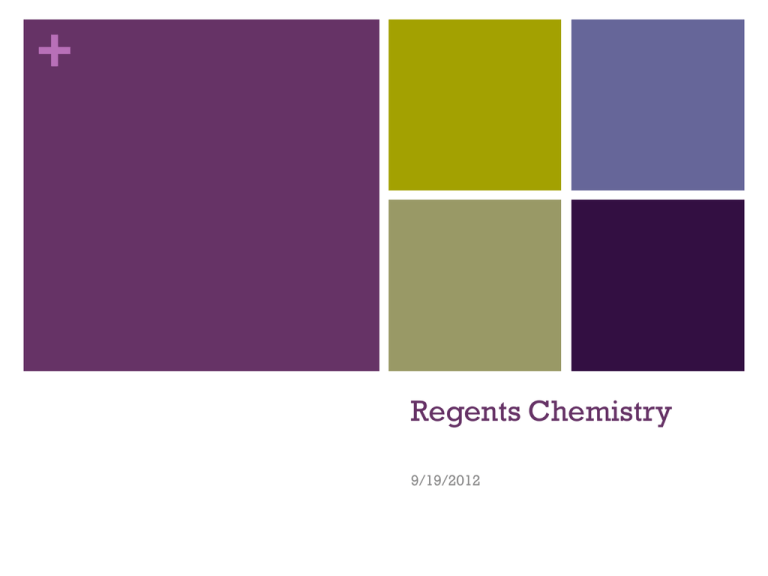File
advertisement

+ Regents Chemistry 9/19/2012 + Do Now Objective: SWBAT describe the separation techniques of mixtures. For Catalyst question: + Review Chemistry is the study of the PROPERTIES, COMPOSITION, and STRUCTURE of matter. Furthermore, it is the study of the REACTIONS that matter undergoes and the ENERGY associated with these changes. A heterogeneous mixture has a composition that is NOT UNIFORM throughout. A homogeneous mixture is a mixture in which the composition is UNIFORM throughout. Another name for a homogeneous mixture is a _SOLUTION_. The term phase is used to describe any part of a sample with uniform composition and properties. A HOMOGENEOUS mixture consists of a single phase. A HETEROGENEOUS mixture consists of two or more phases (e.g. oil on top of water and ice cubes in liquid water). + Agenda Objective: SWBAT describe the separation techniques of mixtures. Explain basis of different separation techniques. Guided, Group, and Group Independent practice Activity: Application of separation techniques. + Guided Notes In a mixture, the various PURE substances retain [keep] their PHYSICAL properties. These differences in PHYSICAL properties can be used to SEPARATE mixtures. + PHYSICAL properties include: density, particle size, solubility, boiling and freezing point, and molecular polarity (charges of the pure substance) + Separating water from oil? Solubility: Water and oil are immiscible. Density: Oil sits on top of water because it is less dense and because of solubility rules Freezing point: Cool the mixture until the oil turns solid. Temperatures at which the olive oil and water freeze are different. + Separating NaCl and Ba3(PO4) salt from water? Boiling point: Salt has a much higher boiling point water vaporizes before salt even melts. Alternative for Ba3(PO4) salt… (Hint: reference table F) Solubility for Ba3(PO4): Refer to Table F Barium phosphate salt is insoluble in water. + Check whether the salt is soluble! + Filtration separates components of a heterogeneous mixture based on particle size. cannot be used on homogeneous mixtures most of the time (particle sizes are too similar). Examples: separate coffee ground from the coffee drink. + Distillation separates mixtures according to their different boiling points. Example: separating water from salt. More than 25°C difference in boiling point Example 2: Fractional distillation of crude oil contains a lot of different components that have different boiling temperatures. + Fractional distillation of Oil Fractional distillation is used when differences in boiling point temperatures are much narrower. General Process: Vaporize Condense at different temperatures. I’ll have you or one of your classmates research and present this! + Group project: Make a poster Directions: Each group will receive a science article on real life applications of the separation techniques learned in class – filtration and distillation. Students must summarize key points in the article and draw an image that represents the process described. Refer to the rubric for how your posters will be assessed. Key points must include: The purpose of the process. What does it produce? The separation technique used. Filtration or Distillation? The basis of the separation technique. Which physical property is being targeted? + Four options + Independent Work “Mixtures Mayhem” (use reference tables to complete. Borrow reference tables to use in class. Electronic version can be found online). “Mixtures” homework sheet. + Exit slip Copy the question and give your response: 1. Given a mixture of water, dirt, feces (poop), and bacteria, name one process that can be used to extract the water. 1. What mixtures cannot be separated by filtration?




